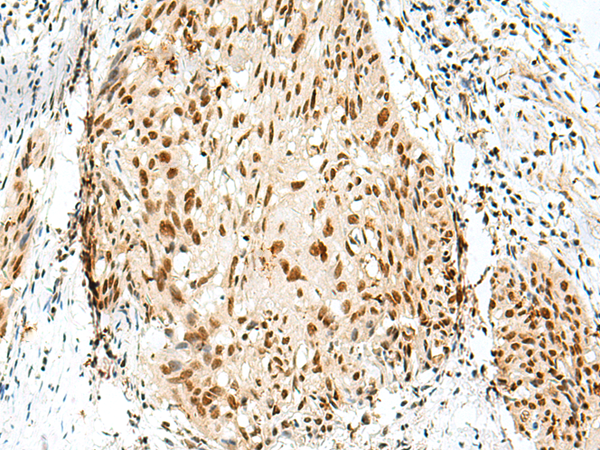
| WB | 咨询技术 | Human,Mouse,Rat |
| IF | 咨询技术 | Human,Mouse,Rat |
| IHC | 1/50-1/300 | Human,Mouse,Rat |
| ICC | 技术咨询 | Human,Mouse,Rat |
| FCM | 咨询技术 | Human,Mouse,Rat |
| Elisa | 1/5000-1/10000 | Human,Mouse,Rat |
| Aliases | S1-1; TARPS; GPATC9; ZRANB5; GPATCH9; DXS8237E |
| Host/Isotype | Rabbit IgG |
| Antibody Type | Primary antibody |
| Storage | Store at 4°C short term. Aliquot and store at -20°C long term. Avoid freeze/thaw cycles. |
| Species Reactivity | Human, Mouse, Rat |
| Immunogen | Fusion protein of human RBM10 |
| Formulation | Purified antibody in PBS with 0.05% sodium azide and 50% glycerol. |
+ +
以下是关于RBM10抗体的3篇示例参考文献(注:以下内容为模拟示例,实际文献需通过数据库验证):
---
1. **文献名称**:*RBM10 modulates apoptosis and proliferation in non-small cell lung cancer through Bcl-x splicing regulation*
**作者**:Wang L, et al.
**摘要**:本研究利用RBM10抗体通过Western blot和免疫组化分析,发现RBM10通过调控Bcl-x mRNA的剪接(促进促凋亡亚型Bcl-xS表达),抑制非小细胞肺癌(NSCLC)细胞增殖并诱导凋亡,提示其作为肿瘤抑制因子的潜在机制。
---
2. **文献名称**:*RBM10 mutations in hepatocellular carcinoma disrupt Wnt/β-catenin signaling*
**作者**:Chen Y, et al.
**摘要**:通过免疫沉淀(IP)和RBM10抗体检测,研究发现肝细胞癌(HCC)中RBM10高频突变导致其与β-catenin结合能力丧失,进而激活Wnt通路,促进肿瘤侵袭,为HCC靶向治疗提供新方向。
---
3. **文献名称**:*RBM10 deficiency promotes alternative splicing of oncogenic transcripts in pancreatic cancer*
**作者**:Smith JA, et al.
**摘要**:利用CRISPR/Cas9敲除和RBM10抗体验证,发现RBM10缺失导致胰腺癌细胞中多个致癌基因(如EGFR、MYC)的异常剪接,促进肿瘤生长和化疗抵抗,揭示其剪接调控功能在癌症中的关键作用。
---
**注**:以上文献为示例,实际研究需通过PubMed、Web of Science等平台检索真实文献(如搜索关键词“RBM10 antibody”、“RBM10 function cancer”等)。
The RBM10 antibody is a crucial tool for studying the RNA-binding motif protein 10 (RBM10), a multifunctional RNA-binding protein involved in regulating alternative splicing, mRNA stability, and apoptosis. RBM10 contains conserved domains, including RNA recognition motifs (RRMs) and a zinc finger domain, enabling interactions with RNA and protein partners. It plays a tumor-suppressive role in various cancers, such as lung adenocarcinoma, by modulating splicing of genes like NUMB and FAS to inhibit uncontrolled cell proliferation. Mutations in RBM10 are also linked to TARP syndrome, a rare X-linked developmental disorder.
RBM10 antibodies, typically raised in rabbits or mice, are widely used in techniques like Western blotting, immunohistochemistry (IHC), and immunofluorescence (IF) to detect RBM10 expression and localization in tissues or cell lines. These antibodies help researchers investigate RBM10's role in splicing dysregulation during carcinogenesis or its interaction with other proteins (e.g., p53). Validated antibodies are essential for ensuring specificity, as RBM10 shares homology with its paralog RBM5. Recent studies highlight its dual role in cancer—acting as either an oncogene or tumor suppressor depending on context—making RBM10 antibodies vital for both basic research and clinical diagnostics.
×